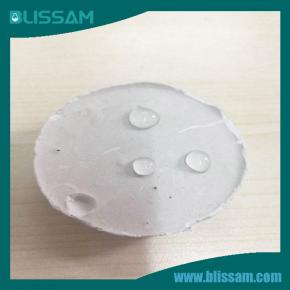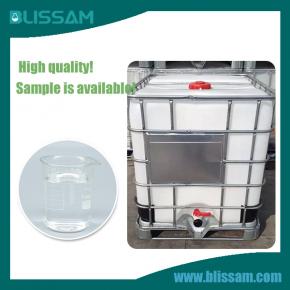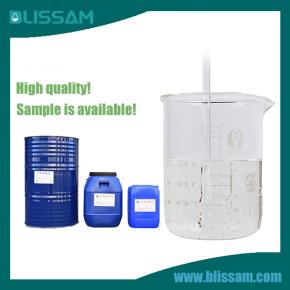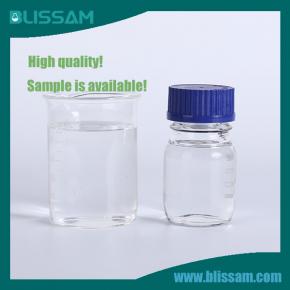ZHEJIANG BLISSAM CHEMICAL CO., LTD. is a leading manufacturer and supplier of high-quality silicone fluids and specialty chemicals. our company has been dedicated to providing innovative products and solutions to various industries, including cosmetics, personal care, textiles, paints and coatings, and many others.
Our state-of-the-art manufacturing facility is equipped with the latest technology and equipment, allowing us to produce a wide range of silicone fluids with various properties and viscosities to meet the unique needs of our customers. We also have a team of experienced chemists who are constantly working towards product development and improvement, ensuring that we offer the most advanced and high-quality products in the market.
Our products are manufactured to the highest standards and undergo rigorous quality control processes to ensure their consistent performance and reliability. We have also obtained various certifications, including ISO 9001:2015, to further demonstrate our commitment to quality.

Introducing our high-performing Silicone Fluids, the ideal solution for all your lubrication and protection needs. Our products are designed to provide superior performance and long-lasting durability, making them perfect for a wide range of applications. With their excellent thermal stability and low volatility, our Silicone Fluids offer reliable protection in high-temperature environments. They also have remarkable resistance to moisture, corrosion, and oxidation, ensuring the longevity of your equipment. Choose our Silicone Fluids for unmatched performance and unrivaled protection. Trust us to keep your machinery running smoothly and efficiently for years to come.
Introducing our revolutionary line of Silicone Fluids - the perfect solution for all your lubrication and insulation needs. Made from the highest quality silicone, our products offer superior heat resistance, unbeatable insulation, and exceptional durability. With a wide range of viscosities to choose from, our Silicone Fluids are suitable for various applications, making them a versatile choice for any industry. Trust in our Silicone Fluids to provide long-lasting lubrication and protection for your equipment, while creating a barrier against moisture, heat, and other adverse elements. Upgrade your lubrication game with our Silicone Fluids and experience the ultimate in performance and efficiency.

Silicone fluids, also known as silicone oils, are a type of synthetic polymer fluid that is commonly used in various industries due to its unique properties. These fluids are composed mainly of silicon atoms and oxygen atoms, giving them a characteristic flexibility and heat resistance. They are available in a wide range of viscosities, making them suitable for a variety of applications including lubrication, release agents, and coatings. With their low surface tension and non-toxic nature, silicone fluids are also commonly used in the cosmetic and personal care industry. In addition, they are highly stable and have excellent electrical insulation properties, making them suitable for use in electronic devices. Overall, silicone fluids offer a versatile and efficient solution for many different industries and applications.
1.What are the characteristics of silicone fluids that make them suitable for use in hydraulic fluids?
2.How are silicone fluids used in the production of medical devices and implants?
3.What are the chemical reactions and processes involved in the production of silicone fluids?
4.How do silicone fluids fulfill the requirements of different regulatory bodies around the world?
5.Can silicone fluids act as a flame retardant in certain applications?
6.What are the potential risks and environmental impact of accidental spills or leaks of silicone fluids?
7.How do manufacturers ensure the quality and purity of silicone fluids in various industries?
1.What are the characteristics of silicone fluids that make them suitable for use in hydraulic fluids?
1. High thermal stability: Silicone fluids have a high resistance to thermal degradation, making them suitable for use in high-temperature applications. 2. Low volatility: Silicone fluids have a low vapor pressure, which means they do not easily evaporate and can maintain their properties over a wide temperature range. 3. Good lubricity: Silicone fluids have excellent lubricating properties, which help reduce friction and wear in hydraulic systems. 4. Wide temperature range: Silicone fluids can operate effectively in both high and low temperatures, making them suitable for use in extreme environments. 5. Chemical inertness: Silicone fluids are chemically inert and do not react with other substances, making them compatible with a wide range of materials used in hydraulic systems. 6. Good dielectric properties: Silicone fluids have high dielectric strength, making them suitable for use in hydraulic systems that require electrical insulation. 7. Low surface tension: Silicone fluids have a low surface tension, which allows them to spread evenly and provide good wetting properties in hydraulic systems. 8. Non-toxic and non-corrosive: Silicone fluids are non-toxic and non-corrosive, making them safe for use in hydraulic systems that come in contact with food or sensitive materials. 9. High shear stability: Silicone fluids have a high resistance to shear forces, which helps maintain their viscosity and performance in high-pressure hydraulic systems. 10. Biodegradable: Some silicone fluids are biodegradable, making them environmentally friendly and suitable for use in applications where environmental impact is a concern.
2.How are silicone fluids used in the production of medical devices and implants?
Silicone fluids, also known as silicone oils, are used in the production of medical devices and implants for their unique properties and benefits. These fluids are made up of long chains of alternating silicon and oxygen atoms, giving them a high degree of flexibility and stability. Here are some ways in which silicone fluids are used in the production of medical devices and implants: 1. Lubrication: Silicone fluids are commonly used as lubricants in the production of medical devices and implants. They have a low surface tension and high viscosity, making them ideal for reducing friction and providing smooth movement in devices such as catheters, syringes, and surgical instruments. 2. Coatings: Silicone fluids are also used as coatings on medical devices and implants to improve their biocompatibility and reduce the risk of infection. These coatings can also provide a smooth and non-stick surface, making it easier for the device to be inserted or removed from the body. 3. Mold release agents: In the manufacturing process of medical devices and implants, silicone fluids are used as mold release agents. They prevent the device from sticking to the mold during the production process, ensuring a smooth and accurate final product. 4. Sealants: Silicone fluids are used as sealants in the production of medical devices and implants. They have excellent adhesion properties and can create a strong and durable seal, making them suitable for use in devices such as pacemakers and artificial joints. 5. Implant lubricants: In the production of implants, silicone fluids are used as lubricants to facilitate the insertion and placement of the implant in the body. They can also help reduce friction and discomfort for the patient during the healing process. 6. Drug delivery systems: Silicone fluids are used in the production of drug delivery systems, such as transdermal patches and implantable drug reservoirs. They can act as carriers for drugs, providing a controlled and sustained release of medication over time. Overall, silicone fluids play a crucial role in the production of medical devices and implants, providing lubrication, biocompatibility, and other essential properties that are necessary for safe and effective use in the human body.
3.What are the chemical reactions and processes involved in the production of silicone fluids?
The production of silicone fluids involves several chemical reactions and processes, including: 1. Hydrolysis: The first step in the production of silicone fluids is the hydrolysis of silicon metal or silicon tetrachloride (SiCl4) in the presence of water. This reaction produces silanol (Si-OH) groups, which are the building blocks of silicone fluids. 2. Polymerization: The silanol groups produced in the hydrolysis step then undergo a condensation reaction, where they combine to form longer chains of siloxane (Si-O-Si) units. This process is known as polymerization and is typically catalyzed by acids or bases. 3. Distillation: The resulting polymer is then distilled to remove any impurities and to control the molecular weight of the silicone fluid. This step is crucial in determining the physical properties of the final product. 4. Functionalization: To modify the properties of the silicone fluid, functional groups such as methyl, phenyl, or vinyl can be added to the siloxane backbone through a variety of chemical reactions. This process is known as functionalization and allows for the customization of silicone fluids for specific applications. 5. Emulsification: In some cases, silicone fluids are emulsified with water to form stable oil-in-water emulsions. This process involves the addition of surfactants and emulsifiers to the silicone fluid, which helps to disperse the oil droplets in water. 6. Cross-linking: Cross-linking is a process where the siloxane chains are linked together to form a three-dimensional network. This can be achieved through the addition of cross-linking agents or by exposing the silicone fluid to high temperatures or radiation. Cross-linking can improve the physical properties of silicone fluids, making them more resistant to heat, chemicals, and mechanical stress. 7. End-capping: End-capping is a process where the silanol groups at the ends of the siloxane chains are reacted with functional groups to prevent further polymerization. This helps to control the molecular weight and viscosity of the silicone fluid. 8. Purification: The final step in the production of silicone fluids is purification, where the product is filtered and treated to remove any remaining impurities. This ensures that the silicone fluid meets the required purity standards for its intended use. Overall, the production of silicone fluids involves a series of chemical reactions and processes that can be tailored to produce a wide range of products with different properties
4.How do silicone fluids fulfill the requirements of different regulatory bodies around the world?
Silicone fluids are versatile and widely used in various industries due to their unique properties and ability to fulfill the requirements of different regulatory bodies around the world. Some of the ways in which silicone fluids fulfill these requirements are: 1. Non-toxic and biocompatible: Silicone fluids are non-toxic and biocompatible, making them suitable for use in medical and pharmaceutical applications. They are approved by regulatory bodies such as the US Food and Drug Administration (FDA) and the European Medicines Agency (EMA) for use in medical devices and pharmaceutical formulations. 2. Chemical inertness: Silicone fluids are chemically inert, meaning they do not react with other substances. This makes them safe for use in food contact materials and packaging, as they do not leach harmful chemicals into food products. They are approved by regulatory bodies such as the FDA and the European Food Safety Authority (EFSA) for use in food contact applications. 3. Thermal stability: Silicone fluids have a high thermal stability, meaning they can withstand extreme temperatures without degrading or releasing harmful substances. This makes them suitable for use in high-temperature applications, such as automotive and aerospace industries. They are approved by regulatory bodies such as the National Highway Traffic Safety Administration (NHTSA) and the Federal Aviation Administration (FAA) for use in these industries. 4. Environmental safety: Silicone fluids are considered environmentally safe as they do not contribute to ozone depletion or global warming. They are also biodegradable, meaning they break down into harmless substances in the environment. This makes them compliant with regulations set by bodies such as the Environmental Protection Agency (EPA) and the European Chemicals Agency (ECHA). 5. Electrical insulation: Silicone fluids have excellent electrical insulation properties, making them suitable for use in electrical and electronic applications. They are approved by regulatory bodies such as the Underwriters Laboratories (UL) and the International Electrotechnical Commission (IEC) for use in these applications. 6. Chemical stability: Silicone fluids are highly stable and do not break down or react with other substances, making them suitable for use in industrial applications such as lubricants and coatings. They are approved by regulatory bodies such as the Occupational Safety and Health Administration (OSHA) and the European Chemicals Agency (ECHA) for use in these applications. In summary, silicone fluids fulfill the requirements of different regulatory bodies around the world due to their non-toxic, biocompatible, chemically inert, thermally stable, environmentally safe, electric

5.Can silicone fluids act as a flame retardant in certain applications?
Yes, silicone fluids can act as a flame retardant in certain applications. Silicone fluids have a high flash point and are non-flammable, making them useful in applications where fire safety is a concern. They can also be used as a coating or additive to materials to improve their fire resistance. Additionally, silicone fluids have a low surface tension, which can help to prevent the spread of flames. However, it is important to note that silicone fluids may not be effective as a standalone flame retardant and may need to be combined with other materials or additives for optimal fire protection.
6.What are the potential risks and environmental impact of accidental spills or leaks of silicone fluids?
1. Contamination of Water Sources: Silicone fluids are insoluble in water and can form a thin layer on the surface of water bodies, preventing oxygen exchange and affecting aquatic life. In case of a spill or leak, the fluid can contaminate nearby water sources, leading to the death of aquatic organisms and disrupting the ecosystem. 2. Soil Contamination: Silicone fluids can also contaminate soil, making it unsuitable for plant growth. This can have a significant impact on agriculture and can also affect the health of animals that feed on contaminated plants. 3. Harmful to Wildlife: If silicone fluids are ingested by animals, it can cause harm to their digestive system and lead to health issues. In addition, the fluid can also coat the feathers or fur of animals, making it difficult for them to regulate their body temperature and leading to hypothermia. 4. Air Pollution: In case of a large spill or leak, silicone fluids can evaporate and form a mist in the air. This can lead to air pollution and affect the respiratory health of humans and animals. 5. Fire Hazard: Some silicone fluids are flammable and can pose a fire hazard if they come in contact with a heat source or an open flame. This can lead to explosions and cause significant damage to the environment and nearby structures. 6. Long-term Environmental Impact: Silicone fluids are not biodegradable and can persist in the environment for a long time. This can have a long-term impact on the ecosystem and can also affect human health if the contaminated environment is used for recreational or agricultural purposes. 7. Damage to Infrastructure: If a spill or leak occurs near infrastructure such as roads, buildings, or pipelines, the silicone fluid can seep into cracks and cause damage. This can lead to costly repairs and disruptions in services. 8. Health Risks for Humans: Exposure to silicone fluids can cause skin and eye irritation, respiratory problems, and allergic reactions in humans. In case of a large spill or leak, nearby communities may be at risk of these health issues. 9. Impact on Marine Life: Silicone fluids can also have a detrimental impact on marine life. In addition to contaminating water sources, the fluid can also coat the gills of fish, making it difficult for them to breathe and leading to death. 10. Cost of Cleanup and Remediation: In the event of a spill or leak, the cleanup and remediation process can be costly and time-consuming. This can also have a significant economic impact

7.How do manufacturers ensure the quality and purity of silicone fluids in various industries?
1. Quality Control Testing: Manufacturers use various testing methods to ensure the quality and purity of silicone fluids. These tests include viscosity, density, refractive index, and chemical composition analysis. 2. Raw Material Selection: The quality of silicone fluids depends on the quality of raw materials used. Manufacturers carefully select and source raw materials from reputable suppliers to ensure the purity and consistency of the final product. 3. Production Process Control: Manufacturers follow strict production processes to ensure the quality and purity of silicone fluids. This includes maintaining proper temperature, pressure, and mixing ratios during production. 4. Filtration and Purification: Silicone fluids are filtered and purified to remove any impurities or contaminants that may affect the quality of the final product. This process helps to ensure the purity of the silicone fluids. 5. Quality Management Systems: Manufacturers implement quality management systems such as ISO 9001 to ensure that all processes and procedures are followed consistently, and any deviations are identified and corrected promptly. 6. Compliance with Industry Standards: Manufacturers adhere to industry standards and regulations set by organizations such as the American Society for Testing and Materials (ASTM) and the International Organization for Standardization (ISO). 7. Quality Assurance Testing: Before the silicone fluids are released for use, manufacturers conduct quality assurance testing to ensure that the product meets the required specifications and standards. 8. Traceability: Manufacturers keep detailed records of the production process, including the source of raw materials, production dates, and batch numbers. This allows for traceability in case of any quality issues. 9. Regular Audits and Inspections: Manufacturers conduct regular audits and inspections of their production facilities to ensure that all processes and procedures are being followed correctly and to identify any potential quality issues. 10. Customer Feedback and Complaints: Manufacturers value customer feedback and take any complaints seriously. They use this feedback to continuously improve their processes and ensure the quality and purity of their silicone fluids.
Contact:
Phone: +86-15957191858
E-mail: info@blissam.com
Whatsapp:+8615957191858
Add: A647, No. 9, Xiyuan Road, Xihu District, Hangzhou, Zhejiang, China
We chat
